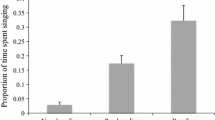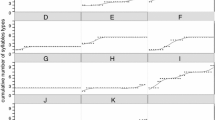Summary
The relationship between song repertoire size and reproductive success was investigated in a population of great reed warblers breeding in southern Germany. No correlations were found between repertoire size and various measures of male quality such as weight, wing length and age. Repertoire size was not correlated with territory size, but showed strong correlations with some measures of territory quality such as the amount of high quality reeds and reed-water interface. Repertoire size and territory quality were both correlated with various measures of reproductive success. Partial correlation analysis revealed that territory quality had a more significant effect upon the number of females obtained, but that repertoire size had a more significant effect upon the number of young produced.
Similar content being viewed by others
References
Beier J (1981) Untersuchungen an Drossel- und Teichrohr-sänger (Acrocephalus arundinaceus, A. scirpaceus): Bestandsentwicklung Brutbiologie, Ökologie. J Ornithol 122:209–230
Catchpole CK (1980) Sexual selection and the evolution of complex songs among European warblers of the genus Acrocephalus. Behaviour 74:149–166
Catchpole CK (1983) Variation in the song of the great reed warbler Acrocephalus arundinaceus in relation to mate attraction and territorial defence. Anim Behav 31:1217–1225
Catchpole CK, Dittami J, Leisler B (1984) Differential responses to male song in female songbirds implanted with oestradiol. Nature 312:563–564
Catchpole CK, Leisler B, Winkler H (1985) Polygyny in the great reed warbler Acrocephalus arundinaceus: a possible case of deception. Behav Ecol Sociobiol 16:285–291
Catchpole CK, Leisler B, Dittami J (in press) Sexual differences in the responses of captive great reed warblers Acrocephalus arundinaceus to variation in song structure and repertoire size. Z Tierpsychol
Howard RD (1974) The influence of sexual selection and interspecific competition on mockingbird song (Mimus polyglottos). Evolution 28:428–438
Krebs JR, Aschroft R, Webber MI (1978) Song repertoires and territory defence in the great tit. Nature 271:539–542
Kroodsma DE (1982) Song repertoires: problems in their definition and use. In: Kroodsma DE, Miller EH (eds) Acoustic Communication in Birds, Vol. 2. Academic Press, New York, pp 125–146
McGregor PK, Krebs JR, Perrins CM (1981) Song repertoires and lifetime reproductive success in the great tit Parus major. Am Nat 118:149–159
Payne RB (1979) Sexual selection and intersexual differences in variance of breeding success. Am Nat 114:447–452
Searcy WA, (1984) Song repertoire size and female preferences in song sparrows. Behav Ecol Sociobiol 14:281–286
Searcy WA, McArthur PD, Yawukawa K (1985) Song repertoire size and male quality in song sparrows. Condor 87:222–228
Yasukawa K, Blank JL, Patterson CB (1980) Song repertoires and sexual selection in the red-winged blackbird. Behav Ecol Sociobiol 7:233–238
Yasukawa K, (1981) Song repertoires in the redwinged blackbird Agelaius phoeniceus: a test of the Beau Geste hypothesis. Anim Behav 29:114–125
Author information
Authors and Affiliations
Rights and permissions
About this article
Cite this article
Catchpole, C.K. Song repertoires and reproductive success in the great reed warbler Acrocephalus arundinaceus . Behav Ecol Sociobiol 19, 439–445 (1986). https://doi.org/10.1007/BF00300547
Received:
Accepted:
Issue Date:
DOI: https://doi.org/10.1007/BF00300547




